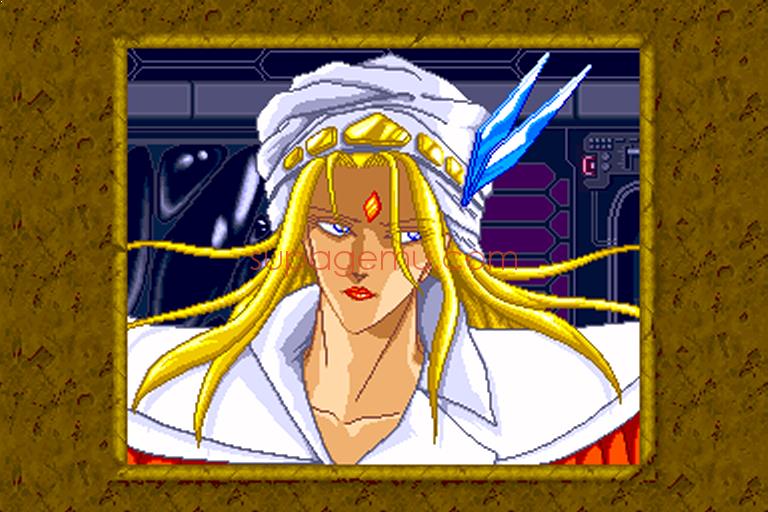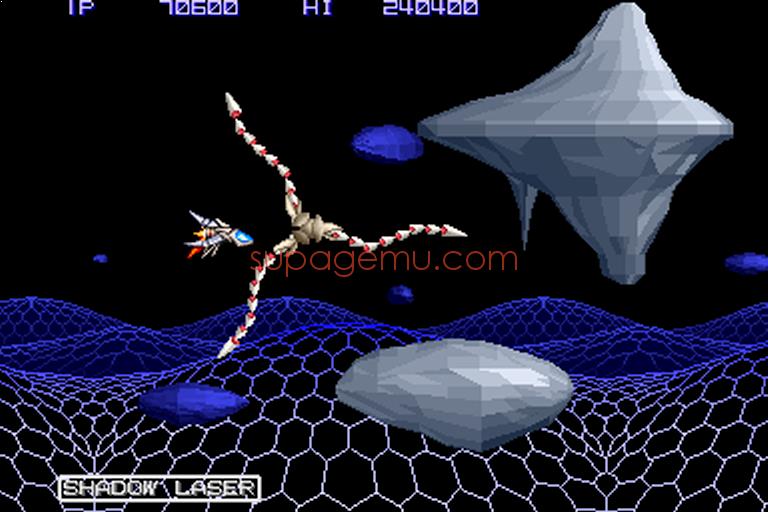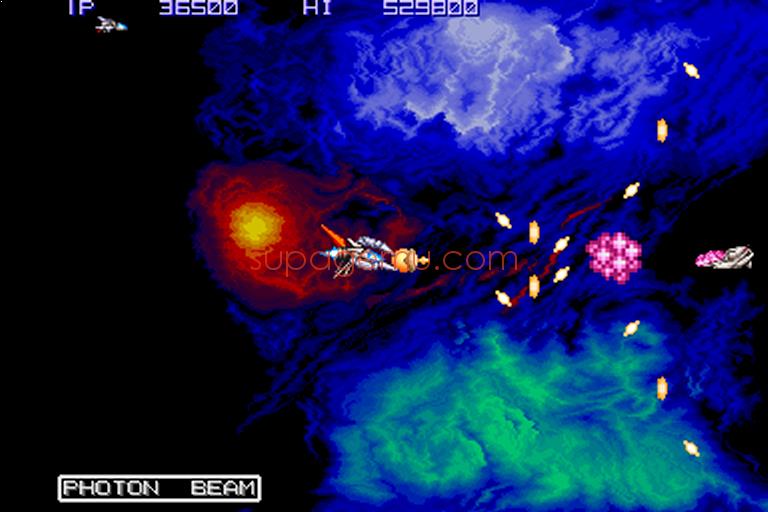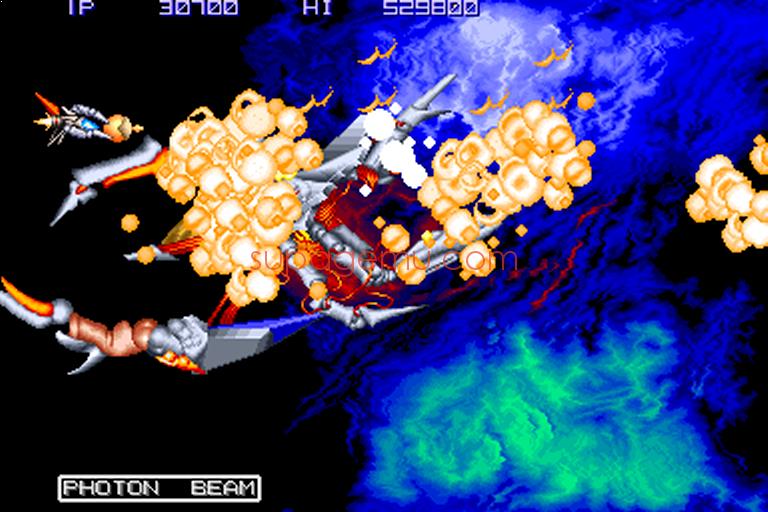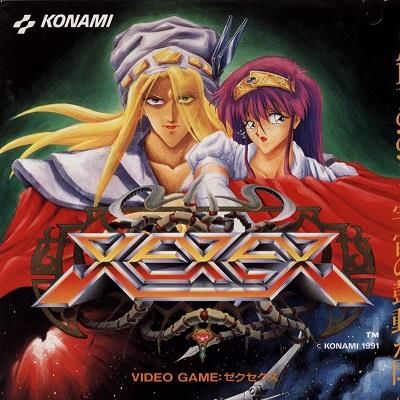
XEXEX
ゼクセクス
Horizontal shoot-them-up
I remember first discovering XEXEX by playing Ganbare Goemon 2 Kiteretsu Shôgun Magginesu on Super Famicom in the mid-90’s. Ganbare Goemon 2 includes a largely downgraded version of the second stage as a mini game. It is nothing close to the arcade version but I was very still impressed by the visuals and the great music.
We, mere humans, do not deserve XEXEX
First, there was nothing. Humans used to lead meaningless lives without any aim. And then there was XEXEX (pronounced “zeks zeks”), the pinnacle of Konami shooters, the true masterpiece of humanity, the real reason we are there, for it is a mesmerizing orgy of colors, rotations, scaling effects, distorted foes, awesome laser weapons, and marvelous tunes leading to true happiness.
When being different leads to bliss
Actually, there was something before XEXEX: Salamander and Gradius II Gofer no Yabô. But those were mere steps leading to XEXEX, which can be considered the ultimate Konami shooter. Let’s take a closer look at some of the staff’s previous works:
- Director, program designer: Toshiaki Takatori: Salamander, Gradius II Gofer no Yabô
- Program designer: T. Fujii: Gradius II Gofer no Yabô
- Graphic Design: Kuniaki Kakuwa: Gradius II Gofer no Yabô
- Sound Designer: Motoaki Furukawa: Gradius II Gofer no Yabô, SD Snatcher, Ajax, Super Contra, etc.
- Sound Designer: Hidenori Maezawa: Mad City (The Adventures of Bayou Billy)
What we can infer from this data is that at least four of XEXEX staff members worked on Gradius II Gofer no Yabô. Some characteristics of the latter can be seen in XEXEX (for example, the infinite vertical scrolling from the first stage of Gradius II is used in XEXEX during levels 3 and 5), but overall, Konami aimed at creating a piece of software that feels different from their previous shooters.
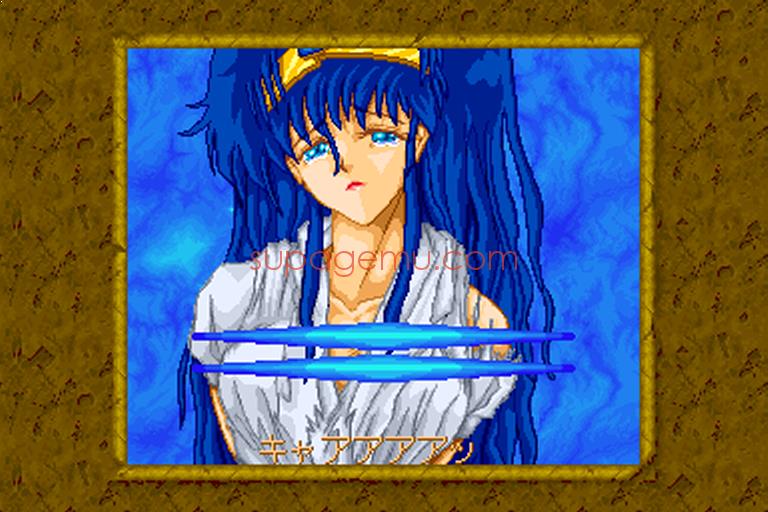
One of the most obvious mean used to achieve that goal was the inclusion of a cute girl. Indeed, with the exception of the colorful Twinbee and Parodius series, most other Konami shooters felt kind of stern and serious back then: Gradius, Salamander, Falsion, Ajax, Thunder Cross, Space Manbow, etc. They generally did not include human characters with a strong personality. So Konami decided to add a beautiful princess called Irene La Tias to make the game more attractive and to appeal not only to hardcore gamers but also to a more mainstream audience. Well, the least we can say is that it didn’t work at all! On the contrary, XEXEX ended up being a forgotten obscure gem that only the most dedicated shooter fans remember. The inclusion of the blue haired princess was a very nice touch though. It is one of the reasons why XEXEX feels different and it gave more personality to the game. On the other hand, the scenario can be considered cliché or even empty (it simply consists of a princess calling for help through telepathy). But it actually works pretty well thanks to two factors. First, the typical Japanese 90’s video games character design is nothing short of excellent. Secondly, the voice acting is outstanding. Indeed, Irene La Tias’s voice actress turns out to be Sumi Shimamoto, a professional who performed the roles of Sarah Crewe (A little Princess Sara), Kyôko Otonashi (Maison Ikkoku), and Nausicaä (Nausicaä of the Valley of the Wind), among others. Her great performance partly explains why Princess Irene feels so alive! As a side note, Irene also appears in Otomedius and Otomedius Gorgeous.
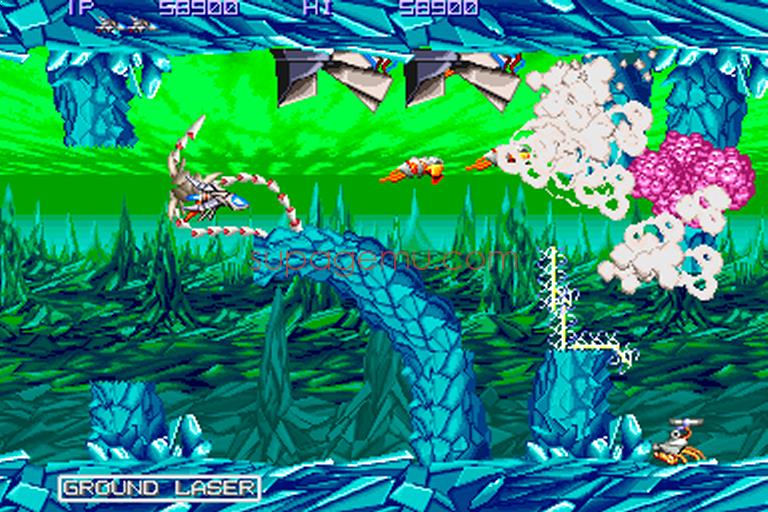
But what makes XEXEX really different from Gradius and Salamander is the gameplay, which is not based on power-ups collection. The handling of the ship, called the “Flintlock”, was obviously heavily influenced by R-Type’s controls. You can either use your detachable orb as a shield by docking it to your ship or let it wander on its own, exactly like in R-Type. You can also charge shots that are released as powerful electrified tentacles. There are some differences though: in XEXEX your ship is always equipped with the detachable orb (called the “Flint”), whereas you have to acquire it as a power-up in R-Type. Contrary to R-Type’s orb, the Flint does not fire by itself: it uses its tentacles to attack the enemies and to protect the ship (it can grow up to three tentacles by collecting “Venom” bonuses). Furthermore, you cannot charge shots while the Flint is away in XEXEX. Finally, the orb can only be docked in the front, while it can be attached on the rear of the ship in R-Type. XEXEX can also vaguely reminds some players of X-Multiply, another shooter from Irem (1989), since the Flint’s tentacles look a little like to the two flexible arms from X-Multiply. But while the Flint’s tentacles move on their own, X-Multiply’s arms can actually be controlled by moving forward and backward. Mastering the control of the Flint is of course crucial. The Flint really changes everything to the gameplay mechanics: thanks to it, XEXEX does not suffer at all from the infamous Gradius syndrome: the difficulty is not linked to how powered up the ship is. The Flint makes the gameplay incredibly interesting and addictive. Indeed, you constantly have to find out the strategy that best fits each segment: docking the flint to use it as a shield while charging shots, or letting it wander while firing rapid shots. One of my favorite strategies is to detach the Flint and to stay near it to be protected by its tentacles while firing rapid shot.
Other than the Flint, XEXEX comes with non-upgradable weapons, which are awesome nonetheless:
- The shadow laser: a godly uber powerful weapon that generates a harmful shadow as the Flintlock moves up and down. It can destroy bosses very quickly, but it won’t fit every situation since you have to move up and down to create the shadow.
- The spiral laser: probably my favorite weapon. It’s not as destructive as the shadow laser, but it combines amplitude with power in a satisfying way. Plus, it’s festive and fun to watch.
- The round laser: a continuous spread shot with good width and reasonable power. It generally works out pretty well in every type of situation.
- The ground laser: it launches a beam that moves across the floor and obviously proves very helpful in areas filled with foes and missile launchers on the ground.
- The homing laser: a 3-way beam that proves useful when you need to shoot up and down.
- The search laser: it fires a homing beam that automatically looks for enemies and bends perpendicularly to change its trajectory. It is especially useful in areas such as level 5, in which small foes and missile launchers swarm by myriads in location that are difficult to reach otherwise. It does not work well when you have to shoot forward.
- The photon beam: the default weapon. It’s nothing special, but being downgraded to the photo beam will not you hinder your progress too much. This is one of XEXEX’s forte: losing power-ups never makes the game too difficult. XEXEX always keeps the player motivated.
OUR DREAMS COME TRUE
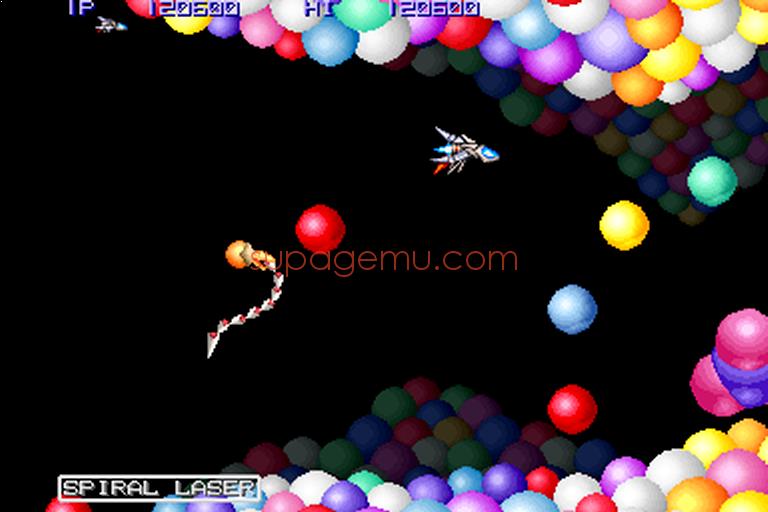
Let me make this clear: XEXEX is gorgeous. It shines so bright it destroys the darkness. The avant-garde visuals and the orgy of technical effects were far ahead of their time. They make the game really stand out and they aged very well. XEXEX starts out very strongly with a magnificent green sky that will make you feel like a junkie hallucinating. But my favorite level is the second one: splendid colorful molecules move around the screen and spin around. These Monza red, steel blue, golden fizz, downy green, and heliotrope purple orbs will make you love science! It is said that J.J. Thomson, Albert Einstein, Max Planck, John Dalton, Niels Bohr, and Ernest Rutherford time traveled to the future to learn about atoms through XEXEX’s second stage. But this high level of technical prowess had a hidden downside: the game could never be ported to a home system, even though there were rumors of ports for the PC Engine Super CD-ROM² and even for the Super Famicom CD-ROM! Ouh, I would have been so happy if XEXEX were released on the Super Famicom CD-ROM and if the Playstation did not exist! I could have been an entirely different man, filled with joy and playing XEXEX, Super Mario World CD, and Zelda CD on the Super Famicom CD-ROM. Anyway, this lack of home version partly explains why the game faded into obscurity, the other reason being the release of Street Fighter II The World Warrior for the arcades in March 1991. XEXEX was an ambitious project, but it was completely overshadowed by Capcom’s phenomenal fighting game. What a tragedy! Fans had to wait until 2007 to see XEXEX being included in Salamander Portable for PSP.
These magnificent visuals and the marvelous soundtrack blend well together. Indeed, the music is nothing short of fantastic! I remember first discovering XEXEX by playing Ganbare Goemon 2 Kiteretsu Shôgun Magginesu on Super Famicom in the mid-90’s. Ganbare Goemon 2 includes a largely downgraded version of the second stage as a mini game. It is nothing close to the arcade version but I was very still impressed by the visuals and the great music: the track from the second stage, which is called “With Zero G”, instantly became one of my favorite track ever! However, when I was finally able to play the entire arcade game, I grew to like the tune from the first stage (“Breeze”) even more. XEXEX’s soundtrack has got something special. It is very energetic (“Battle Cry”, “Breeze”, “Boost up!”, “Crystal Clear”, “Happy Daymare”, “Out of The Blue From The Hyperspace Jump”, etc.), relaxing (“With Zero G”, “Time to Party Hearty!!”, “The Polygonal Energy”, “Birthday Suits”, “My Kutie Pie Irene”, “Jack Pot!”, etc.), and it bursts with Konami’s flavor. Motoaki Furukawa, the founder of the Kukeiha Club, really did an outstanding job with XEXEX’s synth rock soundtrack.
CHARGE THE ENEMY
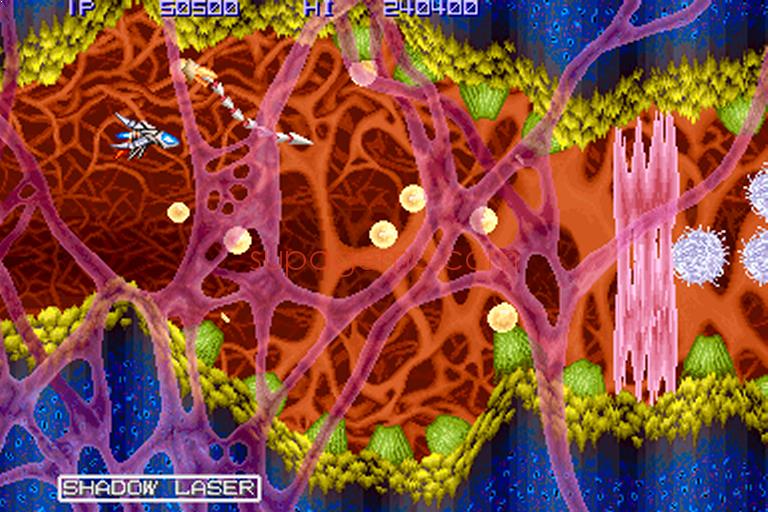
Another characteristic of XEXEX is to be quite challenging. The first four stages are rather easy, but the difficulty level really increases from stage 5, in which bullets swarm like insects. The sixth stage proves also though (you have to redo a whole sequence if you fail to beat the boss), and stage 7 is really hard: it includes a segment in which the screen is filled with enemies and bullets, just before a sequence in which four green walker robots move around the screen (these walker robots are somewhat reminiscent of the Shadow Dancer from Gradius and of its parody, Chichibinta Rika, the Las Vegas Showgirl from Parodius). These two segments suck up a lot of coins. But overall, the difficulty is well balanced and never unfair. Though sequences are mixed with more relaxing segments, and you will never feel unarmed thanks to the Flint, even if you die just before a boss. You can always use the Flint as a shield, let it wander, or charge shots. It’s very motivating.
Japan vs. the World
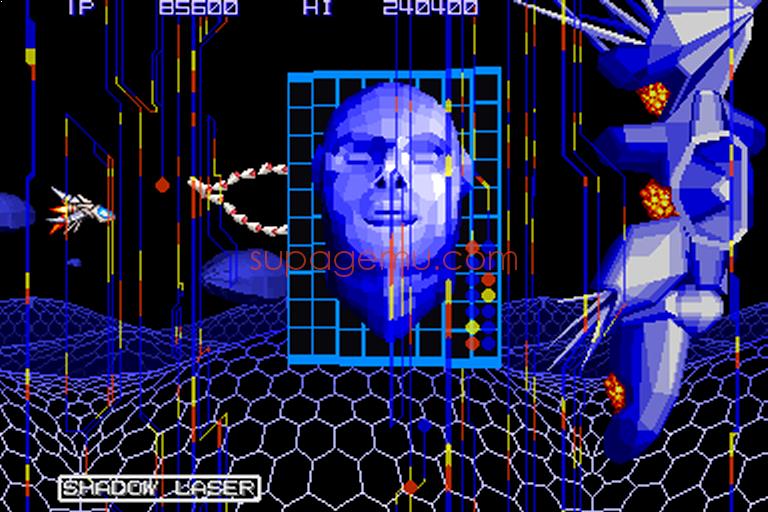
If you plan to buy the arcade PCB, it is HIGHLY recommended to get the Japanese one. In fact, the world version has been so botched up that acquiring it could be considered a crime against good taste. What was originally a perfectly balanced shooter that you have to master patiently by dying and retrying became a huge mess in the West!
First, the world version substitutes a life bar for the lives. Indeed, rather than providing two lives for each credit, it allows the player to be hit multiple times before dying. Secondly, the ship respawns right where it explodes. These two changes prove extremely harmful to the gameplay: instead of learning and finding out the correct strategy for each segment, you simply have to insert coins to make progress. There are no more checkpoints and thus no need to replay parts and to improve. Actually, doing so is impossible with the world version, unless you force yourself to start over from the beginning every time you lose a credit.
To compensate for the life bar that was supposed to make the game easier, the localization team included more enemies shooting an insane amount of bullets! The result is chaos. There are bullets everywhere, and you will necessarily get hit, but you simply don’t care since you have got a life bar. What a disaster. A lot of foes that have nothing to do there appear in an inconsistent way. For example, an antagonist ship that normally comes out during the third stage was included in the beginning of the second level. It clearly feels out of place. Bosses were also modified (for the worse of course): the boss of the sixth stage consists of two satellites instead of just one, causing some slowdown, and even the final boss is accompanied by additional foes!
But that is not all. The weapon system was also made less interesting! All of the awesome weapons such as the spiral laser, the search laser, or the shadow laser have been removed and replaced with only two boring weapons: some kind of spread shot and homing missiles. People who worked on the game’s localization were clearly devils coming from hell to spread hate throughout the world. To make sure they succeed, the final straw was to change the controls. There is no more rapid-fire, and the flint always gets shot forward. That was really idiotic, because there are times when you don’t want to shoot the flint towards foes but simply detach it.
Why do westerners always ruin Japanese games by redrawing covers to make them look ridiculous, by censoring them, or by modifying the gameplay for the worse? The only upside is the two players mode, which is simultaneous, while the Japanese one is alternating.
As a side note, the elusive US version is identical to the world one, except it is called Orius. That arcade PCB is extremely rare and nearly untraceable. It includes the famous “Winners don’t take drugs” logo.
XEXEX is better than sex!
Releasing such a masterpiece as early as 1991 was incredible. XEXEX was ahead of its time, and it was vastly superior to Thunder Cross II, another Konami shooter that was released the same year, and to any other shooter from back then. 1941 Counter Attack, Air Buster, Alpha Mission II, Area 88, Chariot (from Wonder 3), Dragon Breed, Earth Defense Force, Metal Black, X-Multiply, Cotton Fantastic Night Dreams, Dragon Saber, Hellfire, Lethal Thunder, Rezon, Darius II, ThunderForce AC, etc.: none of them could compare to XEXEX. Along with Zelda A Link to the Past, Ganbare Goemon Yukihime Kyûshutsu Emaki, Akumajô Dracula, Magical Chase, Seirei Senshi Spriggan, Hanatãkadaka!?, Aldynes, Final Fantasy IV, and Final Match Tennis, it is one of the reasons why 1991 is my favorite year ever. XEXEX was made with love. The final message at the end of the game proves it. If you like Konami shooters, you MUST play it.
Avant-garde visuals that were far ahead of their time (1991) and even of ours. They are from the future (circa 2291) and come from an era in which good taste will prevail. Each level has got its own theme and they are all gorgeous. The dragon from the third stage looks like Chinese art and the futuristic hexagons from the fifth stage is what our era should have looked like. However, because of its technical achievements and of the rotation and scaling fiesta, XEXEX could never be ported to a home system, the only port being included in Salamander Portable for PSP.
“Battle Cry”, “Breeze”, “With Zero-G”, “Crystal clear”, and “Boost Up” give life a new and powerful meaning. The soundtrack is typical Konami genius work that even the deaf community can appreciate.
The handling of the ship was obviously heavily influenced by R-Type’s controls. You can either use your detachable orb as a shield by docking it to your ship or let it wander on its own, exactly like in R-Type. You can also charge shots that are released as powerful electrified tentacles. That handling proves to be simple and smooth: controls respond perfectly and every parameter was carefully set up by Konami developers. Indeed, the default speed and the hitbox size are just so!
XexeX is challenging, but never unfair or frustrating. The level-design is well balanced between parts requiring memorization and parts testing your reflexes. The possibilities provided by the flint make the game really interesting. You constantly have to find out the strategy that best fits each segment: docking the flint to use it as a shield while charging shots, or letting it wander while firing rapid shots. Furthermore, XEXEX does not suffer at all from the Gradius/R-Type syndrome: losing power-ups never makes the game impossible or incredibly difficult to resume. Indeed, in XEXEX, the ship is always equipped with the flint, which provides multiples protection and attack possibilities.
The story is really simple. A damsel in distress called Irene La Tias from the planet E-square calls for help. Her planet is in danger and she has been kidnapped by Klaus Pachel Bell, an effeminate villain who tortures her. What a bastard! We have to save Irene! These two characters are very well drawn and surprisingly express strong personalities, thanks to their voices and design. The little entertaining scenes after each level enable the player to relax for a few seconds and to get into the story.
XEXEX does not innovate much in terms of gameplay. It mostly picks up ideas from Gradius and R-Type. However, it does feel different from other Konami shooters in terms of visuals. The use of several technical effects also makes it stand out.
XEXEX’s length is pretty standard for a shooter. It consists of seven levels, but the last three stages prove to be quite challenging. Furthermore, the second loop is insanely hard and will keep you busy for a long while if you plan to beat it too.
FINAL SCORES
XEXEX is one of the best old school shooter ever. It combines technical prowess with excellent and challenging gameplay. It is a real gem that deserved a lot better than sadly fading into oblivion.
The score on the left is for mere mortals who cannot fathom the truth. We, mere humans, do not deserve XexeX, for all the sins we committed throughout the centuries. That game is so perfect in every way: the psychedelic visuals are the most beautiful works of art you will ever see without taking drugs (remember: “Winners Don’t Use Drugs”), piloting the Flintlock feels better than piloting your wife, and Mozart could not have composed the soundtrack even if he were Japanese, born in the 70s, and had 50 more IQ points. XEXEX getting a perfect score only makes perfect sense.






































